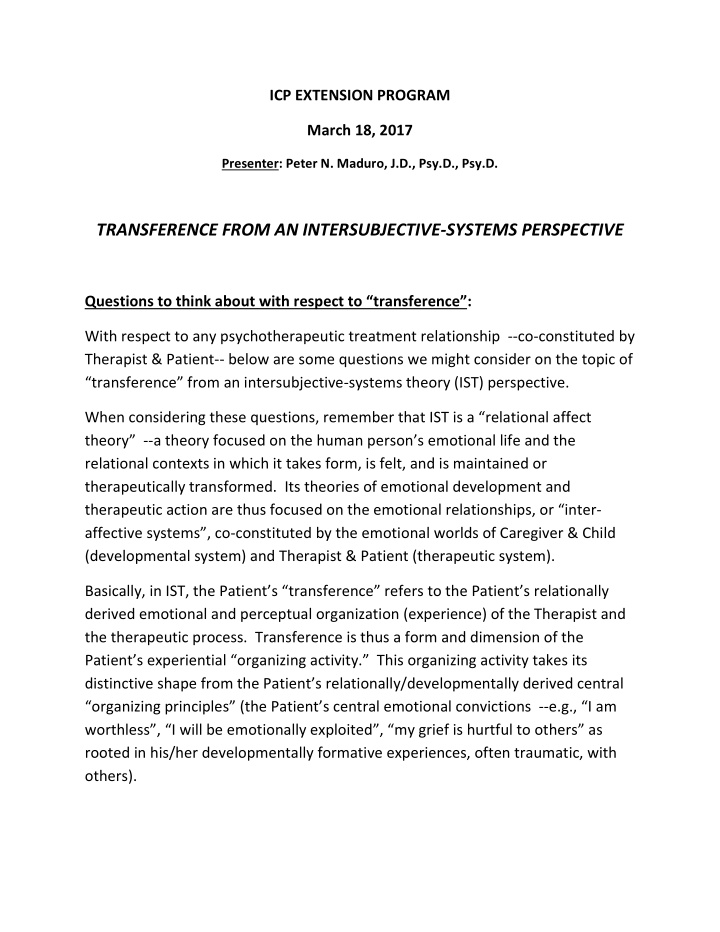



ICP EXTENSION PROGRAM March 18, 2017 Presenter: Peter N. Maduro, J.D., Psy.D., Psy.D. TRANSFERENCE FROM AN INTERSUBJECTIVE‐SYSTEMS PERSPECTIVE Questions to think about with respect to “transference”: With respect to any psychotherapeutic treatment relationship ‐‐co‐constituted by Therapist & Patient‐‐ below are some questions we might consider on the topic of “transference” from an intersubjective‐systems theory (IST) perspective. When considering these questions, remember that IST is a “relational affect theory” ‐‐a theory focused on the human person’s emotional life and the relational contexts in which it takes form, is felt, and is maintained or therapeutically transformed. Its theories of emotional development and therapeutic action are thus focused on the emotional relationships, or “inter‐ affective systems”, co‐constituted by the emotional worlds of Caregiver & Child (developmental system) and Therapist & Patient (therapeutic system). Basically, in IST, the Patient’s “transference” refers to the Patient’s relationally derived emotional and perceptual organization (experience) of the Therapist and the therapeutic process. Transference is thus a form and dimension of the Patient’s experiential “organizing activity.” This organizing activity takes its distinctive shape from the Patient’s relationally/developmentally derived central “organizing principles” (the Patient’s central emotional convictions ‐‐e.g., “I am worthless”, “I will be emotionally exploited”, “my grief is hurtful to others” as rooted in his/her developmentally formative experiences, often traumatic, with others).
2 Similarly, the Therapist’s “transference,” often called the Therapist’s “countertransference”, refers to the Therapist’s relationally derived emotional and perceptual organization of the Patient and the therapeutic process. The Therapist’s transference takes its distinctive shape by virtue of being organized by the Therapist’s relationally/developmentally rooted central “organizing principles” (the Therapist’s central emotional convictions ‐‐e.g., “I am responsible to keep other’s safe from pain”, “If I do not always‐already know, understand, and have answers for those I care about, I am a failure”, as rooted in his/her developmentally formative experiences, often traumatic, with others). The “transference/counter‐transference system”, namely, the system of emotional meanings co‐constituted by the Therapist’s and Patient’s mutually and reciprocally influencing central “organizing principles” and associated “transferences”, is thus a particularly important dimension of the therapeutic relationship. Finally, as you consider the questions below, imagine a particular person in your practice as “the Patient”, and imagine yourself as “the Therapist.” Now, finally, to the questions: 1. How Would You Describe the Patient’s Emotional World? (a) How would you describe the emotional convictions, or organizing principles, at the center of the Patient’s personality? (b) What “hopes and dreads” (Mitchell) or longings and anxieties might most centrally and repetitively characterize the Patient’s emotional experience? 2. What Is/Are the Patient’s Transference(s) With the Therapist? If “transference” is defined as the Patient’s experience of the Therapist and therapeutic situation & process as organized by the Patient’s central “organizing principles”, then (a) What “hopes” or developmental longings might you expect the Patient to consistently experience (whether or not consciously) in his therapeutic
3 treatment? What is he or she likely to most deeply long for from his or her Therapist, and the therapeutic process? (b) What anxieties or dreads are likely to repetitively organize the Patient’s experience and expectations in respect of his or her Therapist, and the treatment process? What is he or she likely to be most afraid of and most sensitive to re‐occurring in the Therapist’s way of being and therapeutically interacting with him or her? 3. What Is/Are the Therapist’s Transference(s) With the Patient and How Do They Impact the Patient? How Do They Become Therapeutically or Traumatically Organized By the Patient? If we think of the Therapist’s own central organizing principles as the Therapist’s “transference” ‐‐or the “countertransference”‐‐ in respect of the given Patient and his or her treatment of such Patient, then (a) What aspects of the Therapist’s personal organization are apt to get mobilized or evoked by the Patient’s (i) developmental transferences (longings) and (ii) repetitive transferences (dreads of retraumatization)? (b) What aspects of the Therapist’s personal organization and associated transferences are likely to lend themselves to meeting the Patient’s particular longings, e.g., to understanding or seeing him or her well and promoting therapeutic transformation? (c) Which aspects of the Therapist’s organization and associated transferences are likely to lend themselves to evoking or confirming the Patient’s dreads or anxieties? (d) What features of the Therapist’s theoretical convictions & commitments, and derivative therapeutic style, clinical activity, or general attitude might lend themselves to meeting the Patient’s longings or evoking his or her anxieties? (e) If the Therapist is affiliated with a clinic, agency or other organization (e.g., Maple Center Counseling Center; Airport Marina Counseling Service; Kaiser in‐house clinic) that has its own personality, policies, aesthetic, reputation etc, and which, by virtue of such affiliation, is identified with the Therapist
4 in the Patient’s mind, what features of such organization might lend themselves to meeting the Patient’s longings or evoking his or her anxieties?
Recommend
More recommend